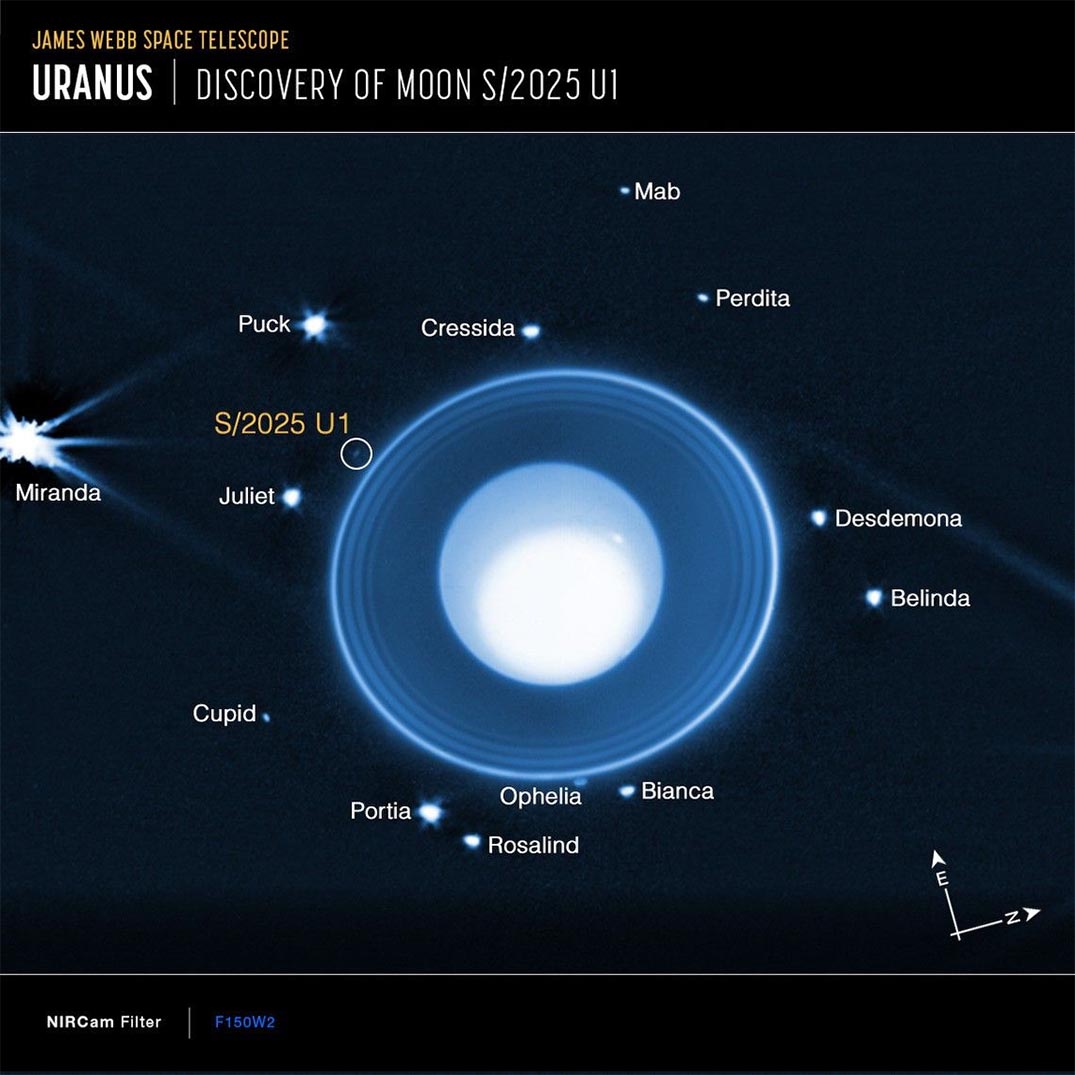Using NASA’s James Webb Space Telescope, a team led by the Southwest Research Institute (SwRI) has identified a previously unknown moon orbiting Uranus, expanding the planet’s known satellite family to 29.
The detection was made during a Webb observation on 2 February 2025.
“This object was spotted in a series of 10 40-minute long-exposure images captured by the Near-Infrared Camera (NIRCam),” says Maryame El Moutamid, a lead scientist in SwRI’s Solar System Science and Exploration Division. “It’s a small moon but a significant discovery, which is something that even NASA’s Voyager 2 spacecraft didn’t see during its flyby nearly 40 years ago.”
This timelapse animation shows the newly discovered moon of Uranus, designated S/2025 U1, as well as 13 of the 28 other known moons orbiting the planet. The observations by NASA’s James Webb Space Telescope’s NIRCam (Near-Infrared Camera) were taken over the course of about six hours on 2 February 2025, under program ID 6379 (principal investigator: M El Moutamid). The animation is comprised of data taken with NIRCam’s wide band F150W2 filter, which transmits infrared wavelengths from about 1.0 to 2.4 microns. Due to the drastic differences in brightness levels, the animation is a composite of three different treatments of the data, allowing the viewer to see details in the planetary atmosphere, the surrounding rings, and the orbiting moons.
NASA, ESA, CSA, STScI, M El Moutamid (SwRI), M Hedman (University of Idaho). Animation: J DePasquale (STScI).
The newly-discovered moon is estimated to be just 10km in diameter, assuming it has a similar reflectivity (albedo) to Uranus’ other small satellites. That tiny size likely rendered it invisible to Voyager 2 and other telescopes.
“No other planet has as many small inner moons as Uranus, and their complex inter-relationships with the rings hint at a chaotic history that blurs the boundary between a ring system and a system of moons,” says Matthew Tiscareno of the SETI Institute, a member of the research team. “Moreover, the new moon is smaller and much fainter than the smallest of the previously known inner moons, making it likely that even more complexity remains to be discovered.”

Astronomers using NASA’s James Webb Space Telescope discovered a new moon orbiting Uranus in images taken by Webb’s NIRCam (Near-Infrared Camera). This image shows the moon, designated S/2025 U1, as well as 13 of the 28 other known moons orbiting the planet. (The small moon Cordelia orbits just inside the outermost ring, but is not visible in these views due to glare from the rings.) Due to the drastic differences in brightness levels, the image is a composite of three different treatments of the data, allowing the viewer to see details in the planetary atmosphere, the surrounding rings, and the orbiting moons. The data was taken with NIRCam’s wide band F150W2 filter that transmits infrared wavelengths from about 1.0 to 2.4 microns. NASA, ESA, CSA, STScI, M El Moutamid (SwRI), M Hedman (University of Idaho)
The new moon is the 14th member of the intricate system of small moons orbiting inward of the largest moons Miranda, Ariel, Umbriel, Titania, and Oberon. (All the moons of Uranus are named after characters from Shakespeare and Alexander Pope.)
“It’s located about 56 000km from Uranus’s centre, orbiting the planet’s equatorial plane between the orbits of Ophelia (which is just outside of Uranus’ main ring system) and Bianca,” says El Moutamid. “Its nearly circular orbit suggests it may have formed near its current location.”
A name for the newly found moon will need to be approved by the International Astronomical Union (IAU), the leading authority in assigning official names and designations to astronomical objects.
“Through this and other programs, Webb is providing a new eye on the outer solar system. This discovery comes as part of Webb’s General Observer program, which allows scientists worldwide to propose investigations using the telescope’s cutting-edge instruments. The NIRCam instrument’s high resolution and infrared sensitivity make it especially adept at detecting faint, distant objects that were beyond the reach of previous observatories,” says El Moutamid.
“Looking forward, the discovery of this moon underscores how modern astronomy continues to build upon the legacy of missions like Voyager 2, which flew past Uranus on Jan. 24, 1986, and gave humanity its first close-up look at this mysterious world. Now, nearly four decades later, the James Webb Space Telescope is pushing that frontier even farther.”
